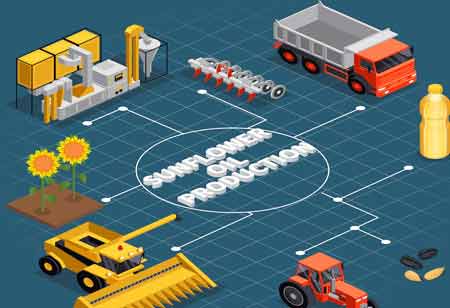Thank you for Subscribing to Agri Business Review Weekly Brief
Advanced Technologies Shaping the Future of Grain Handling
The growing need for efficient grain handling, storage, and processing solutions is becoming more crucial for farmers, traders, organizations, and nations, as this article explores in detail the various aspects of grain storage, processing, handling equipment, and grain processing.

By
Agri Business Review | Friday, October 03, 2025
Stay ahead of the industry with exclusive feature stories on the top companies, expert insights and the latest news delivered straight to your inbox. Subscribe today.
Fremont, CA: The need for efficient grain handling, storage, and processing solutions has become more critical than ever for farmers, traders, organizations, and nations. This increased demand is largely driven by political instability and trade restrictions, which have caused significant disruptions and shortages in the global supply chain. As grain prices continue to rise due to reduced supply from certain countries, both governmental and non-governmental entities are actively seeking new facilities to extend grain storage periods, ultimately strengthening food safety and security.
Trends in Grain Storage
Grain storage has experienced a significant transformation from conventional aerial storage methods to contemporary solutions, including warehouses, airtight bags, and bulk grain silos, driven by climate change and food safety issues. These modern structures are designed to safeguard grains against moisture, pests, and temperature variations, extending their storage duration.
Various types of bulk grain silo storage exist, including hopper bottom silos and flat bottom silos, each available in a range of capacities. Additionally, galvanized iron corrugated (GIC) silos are pretty popular among industries in India.
Grain bunkers are recognized as a highly cost-effective and scientifically sound solution for storing grain over short to medium durations. Their capacities range from approximately 500 metric tons to as large as 30,000 metric tons.
Grain-Handling Equipment
In contemporary grain storage and processing facilities, mechanical conveyors are essential for transporting grain, flour, feed, and various other products.
Producers have access to an extensive range of grain-handling equipment, which includes sieves, sample bags, belt-and-bucket elevators, sack elevators, drag chain conveyors, belt conveyors, augers (screw conveyors), and grain receivable choppers, among other options.
A significant portion of this equipment is characterized by efficiency, versatility, adaptability, and high capacity; however, they tend to generate considerable noise during operation and can be expensive, limiting accessibility for smallholder farmers.
These machines are engineered to reduce grain damage, a critical aspect given that pulses are more vulnerable to impact damage than cereals. Grain producers and processors recognize the necessity of preserving grain quality, as it directly impacts their profitability. Consequently, investing in tailored grain-handling equipment is essential for safeguarding grain reserves and enhancing operational efficiency.
Grain Processing
Cereals experience several processing stages from the time of harvest until they are consumed. This sequence of operations is commonly known as the total post-harvest system.
In many countries, the post-harvest system can be categorized into three specific areas: the preparation of harvested grains for storage, primary processing—which includes additional treatments to clean the grains, remove the husk, or reduce their size—and secondary processing, which converts the grains into consumable products.
Various processes are engaged by numerous grain processors during the primary processing stage, including cleaning, grading, hulling, milling, pounding, grinding, tempering, parboiling, soaking, drying, and sievi





